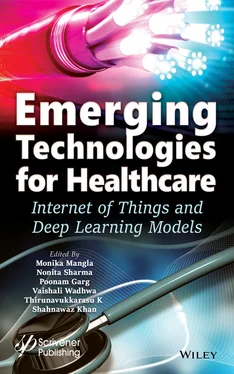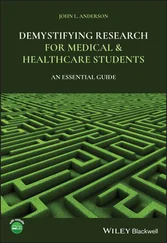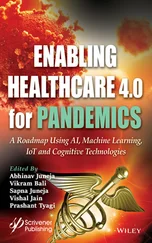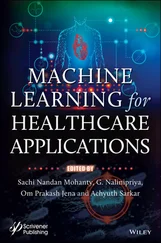1.7.10 Detection of Cancer
Early detection of cancer is very important to save the life of an individual. Due to the advancement in technology, sensors are attached to the connected wearable devices which can sense any abnormalities in the cell.
The most common and dangerous cancers seen among women is breast cancer, and if it is not detected at an early stage, it leads to fatal condition.
With the advancement in new technologies, sensor-enabled bras are developed which makes use of Artificial Intelligence which, when worn, can detect abnormalities in breast tissues. These bras need not be worn throughout for detection; women can wear this bra for 2 to 12 hours per month. This wearable sensor embedded cloth does not produce any radiations or side effects. This can detect breast cancers at an early stage so that the treatment can start at an early stage for which complete cure is possible.
These wearable devices reduce the cancer risk among women and can reduce the treatment expenses as the doctors and patients will be alerted about the abnormalities in the tissues.
1.7.11 Monitoring Parkinson Patient
Parkinson is a health condition in which brain behaves abnormally which leads to difficulty in movement and coordination. Parkinson affects the central nervous system so the patients may feel stiffness and loss balance in movement.
It is very important to monitor the Parkinson patients on real time. With IoT devices, regular monitoring of Parkinson’s patients is possible. Patients may suddenly face lack of movement which is very common in Parkinson disease called Freezing of Gait (FOG). This FOG stage can be detected by means of IoT devices and alerts can be given to doctors and patients. Even early detection of symptoms of this disease is also possible by the use of IoT devices.
In future, such devices will help the Parkinson’s patients to lead a better life without risking their lives.
1.7.12 Ingestible Sensors
Sensors are embedded into the pills which can be ingested by the patients. These sensors will monitor whether the patient has taken prescribed medicines at the right time. If the medicines are not taken properly, it will be alerting through the connected devices.
Most of the times patients does not follow doctor’s prescription, they either miss to take medicines on time or they may take overdose of the medicines. They may not follow the proper time gap for each medicine. All these issues may lead to serious medical conditions and result in expensive medical treatments.
These situations can be avoided by ingestible sensors which regularly monitors the patients and alerts them to take medicines on time. Taking care of the patients also becomes much easier with the support of such smart devices.
1.7.13 Surgery by Robotic Devices
Robotic surgeries are becoming common nowadays, owing to the precision, it gives compared to the normal surgeries performed by the doctors.
Robots connected to IoT devices can perform complex surgeries with more precision and control by the supervision of doctors. Doctors even can instruct robots to perform surgeries sitting at a remote location.
This can save many lives as quick action is possible even at a remote location. Many of the surgeries lasts for hours to complete which is a tiresome job for the doctors. In such situation, robots can perform the surgeries with much better precision. Complicated surgeries can be done successfully with the help of robotic devices connected to IoTs. This gives new dimensions to the classical surgery procedures.
Due to the current Covid-19 pandemic situation, the awareness about the importance of hand hygiene is increased among the common public. Proper care should be taken to prevent the spread of diseases especially in healthcare facilities. IoT-enabled devices play a major role in maintaining the hygiene of healthcare workers and patients.
With sensor-enabled hand sanitizing machines, monitoring of hand hygiene becomes easier. The sensor sets a threshold value of cleanliness and, if any staff fails to maintain the threshold value, will be alerted about sanitizing their hands. Even the sensors can track the time of sanitization done and alert them to sanitize their hands.
Since real-time monitoring of the hand hygiene is possible by the IoT connected devices, everyone will be more aware and alerted about the cleanliness and importance of the hygiene hands which leads to a healthy environment and helps to control the spread of viruses.
1.7.15 Efficient Drug Management
Using IoT-enabled devices management of drugs can be done in an efficient manner starting from the production to the supply chain management.
Radio Frequency Identification (RFID) tags are used for distribution purpose which also records a real-time record of the availability of the drugs and whether distribution is correctly done. The temperature during production process is also monitored to detect any variations.
With the proper supply chain management, production cost can be reduced and patients will get good quality drugs at a reduced rate.
Alzheimer is a dreaded disease for elderly people and their loved ones as handling such patients is a difficult task. The patients tend to forget their daily activities and many of them loss their way back home and it creates difficulty in locating them.
IoT-enabled devices with smart GPS sole embedded system will provide a solution for this problem. It tracks the patient’s location and updates it into the connected devices. It is a waterproof system so even if the patient enters water bodies, it will be working and sending signals to the connected devices. It will alert the loved ones about the location of the patients if they are wandering anywhere. This device is easy to wear as it is embedded into the sole and patients will never forget to wear footwear while going out.
Such smart devices will help Alzheimer patients to lead a healthy and normal life.
To lead a healthy life, regular body checkups are required but most of the time people ignore the checkups on regular basis. To overcome this, a smart body scanner which scans the body and updates about the variations in body parameters can be used.
The scanner is basically a full-length mirror with a 3D camera and a weigh scale which scans the entire body and stores the images and the data will be used for processing the results in a mobile application. This application will create a graphical chart about the variations in body dimensions and parameters which will be helpful in maintaining fitness.
1.7.18 Medical Waste Management
Hospital waste management is a difficult problem faced by the healthcare facilities throughout the world. If these bio medical wastes are not disposed properly, it may lead to spread of infectious diseases. IoT-enabled waste management system will provide a smart solution to this problem.
Sensor-enabled dustbins may be used which is connected through IoT devices. The sensors detect the amount of trash present and automated messages will be generated to dispose the waste when the garbage bin is full. Through the connected devices, autonomous robots can fetch the garbage and dispose it in a smart way.
As robots are involved in disposing medical wastes, this may reduce the risk of spreading of the diseases through housekeeping staff who generally deals with disposal of garbage. This smart way of waste disposal will keep the hospital environment clean and safe.
1.7.19 Monitoring the Heart Rate
Читать дальше












